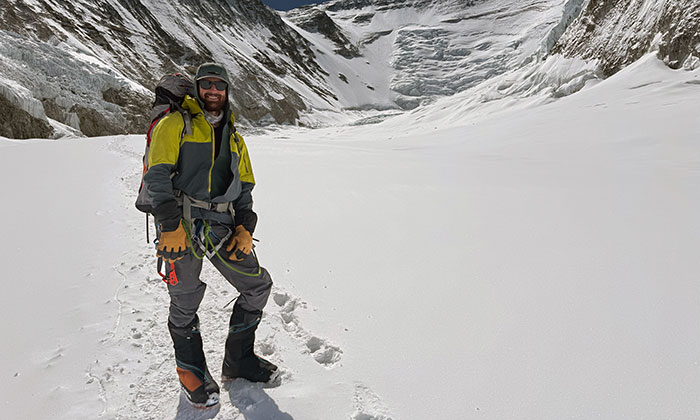David Fathalikhani didn’t want to climb Mount Everest – at least not at first.
“There’s a huge cult of ego and competition surrounding Mount Everest because it’s the highest peak in the world,” he explained. “I wanted no part of that. I like to climb peaks that excite me personally, not to check off a bucket list.”
But after the physical therapist and avid mountaineer visited Nepal to climb neighboring Ama Dablam, Fathalikhani knew he had to take on the challenge of Everest.
“The sherpa guides that I climbed Ama Dablam with encouraged me to come back and do Mount Everest after that,” he said. “I was at a point in my life where I had two months free, so I thought, ‘When else will I have this opportunity?’”

And so began Fathalikhani’s two-month journey to summit the tallest mountain in the world. While he knew the almost 30,000-foot climb would be challenging, he was well prepared after climbing mountains in South America, Asia and the U.S. for 10 years. His mountaineering journey began during his graduate school years.
“During a break, I traveled to Washington and took a mountaineering course and I was hooked,” Fathalikhani said. “I love the tranquility of connecting with nature. When I climb, I break away from my usual routines and it’s a great opportunity to reconnect with myself.”
He continued to climb in his free time while enrolled in Marymount University’s Doctor of Physical Therapy program. As a DPT student, he liked learning to “safely push the boundaries of the human body” and take on new challenges.
“Everest is a big physical challenge for sure, but really the mental and emotional stress are the hardest things to deal with,” Fathalikhani said. “You’re just uncomfortable for weeks, sleeping on the snow in single-digit weather at the mercy of the elements. After a while, you just start asking yourself, ‘What am I doing? How did I get here?’”
But he credits a positive attitude and camaraderie with allowing him to succeed during a dangerous climb.
“My climbing partners helped me stay positive,” he continued. “Whenever we would feel the discomfort getting to us – like when there were five of us trying to sleep, piled on top of each other in a two-person tent – we would just laugh at how ridiculous the situation was and how lucky we were to have the chance to do it.”
Finally summiting Everest by the light of a full moon, he realized all of the discomfort had been worth it.
“It was an indescribable feeling. Walking those last few meters up onto the summit, seeing the Big Dipper so clear in the sky above us. Everyone was high-fiving and hugging and celebrating. At that moment, I just felt so grateful for a safe and successful journey.”

Although the climb was memorable enough, he says the relationships he formed during the expedition meant the most to him.
“I still talk with my climbing guide, Dandu Sherpa, and some of the guys I climbed with a couple times a week,” Fathalikhani said. “This is the kind of experience that transcends culture and differences in personalities. It bonds you together and gives you something that only you share.”
Now, after enjoying his time in Nepal so much, he’s eager to give back to the villagers of remote mountain towns around Everest by providing free medical services, physical therapy, occupational therapy and speech therapy. To accomplish this, he is expanding his concierge physical therapy company, Summit Rehab Services, into an international health care company called Summit Global Health Initiatives, aimed at serving communities abroad.
“Anyone can bring services to underserved communities, but we want to ensure that they are the right services,” Fathalikhani said. “In Nepal, for example, their biggest problem is transporting medical supplies. The villages are so remote, they are a three or four-day walk. It’s difficult to get equipment out there by car, so they have to carry everything they need on their backs. If we could find ways to increase the volume of medical supplies they can transport, we could help improve the health of the community immensely.”
His desire to help those abroad stems from a service-learning trip to Costa Rica while he was a Marymount DPT student. He also credits the University’s faculty for sparking his passion for global health.
“I think the Marymount program does an amazing job preparing you to be a great clinician in whatever setting you want to go into,” he reflected. “The faculty really care about making you into the best practitioner you can be. I still stay in contact with some of my Marymount professors and they have been so supportive through my whole career. When I announced my Everest expedition, I got an outpouring of support from them, which felt amazing. They embody the person-first approach to health care which has become the basis for my personal philosophy.”
While he dedicates most of his time to establishing the new international branch of Summit Rehab, he plans to continue challenging himself in all areas of life, including climbing.
“When we challenge ourselves and do hard things, that’s when we discover who we really are.”





